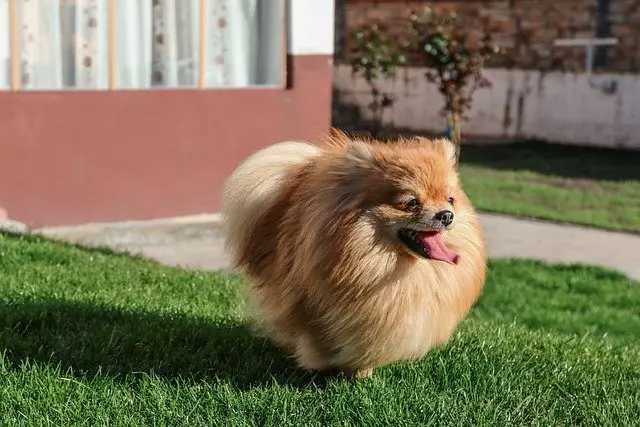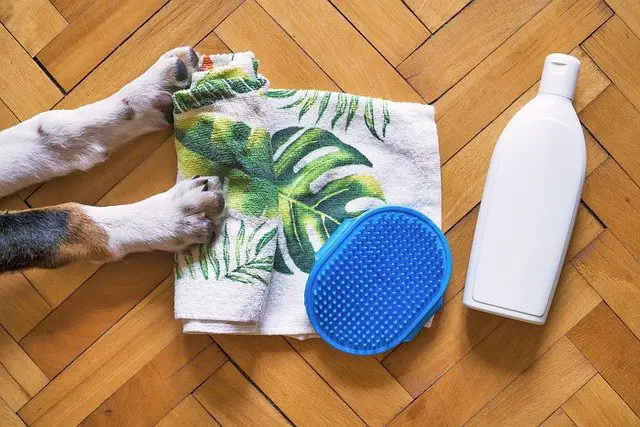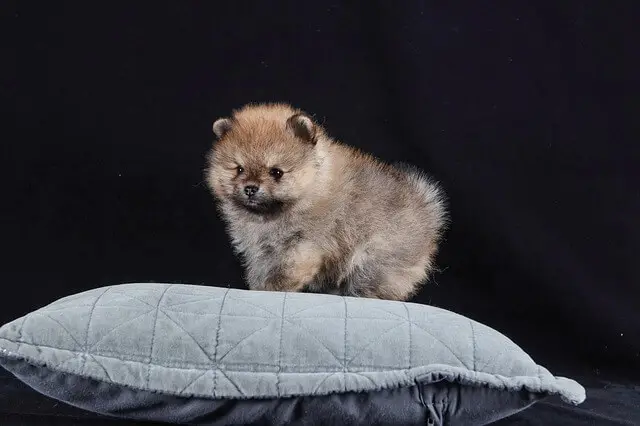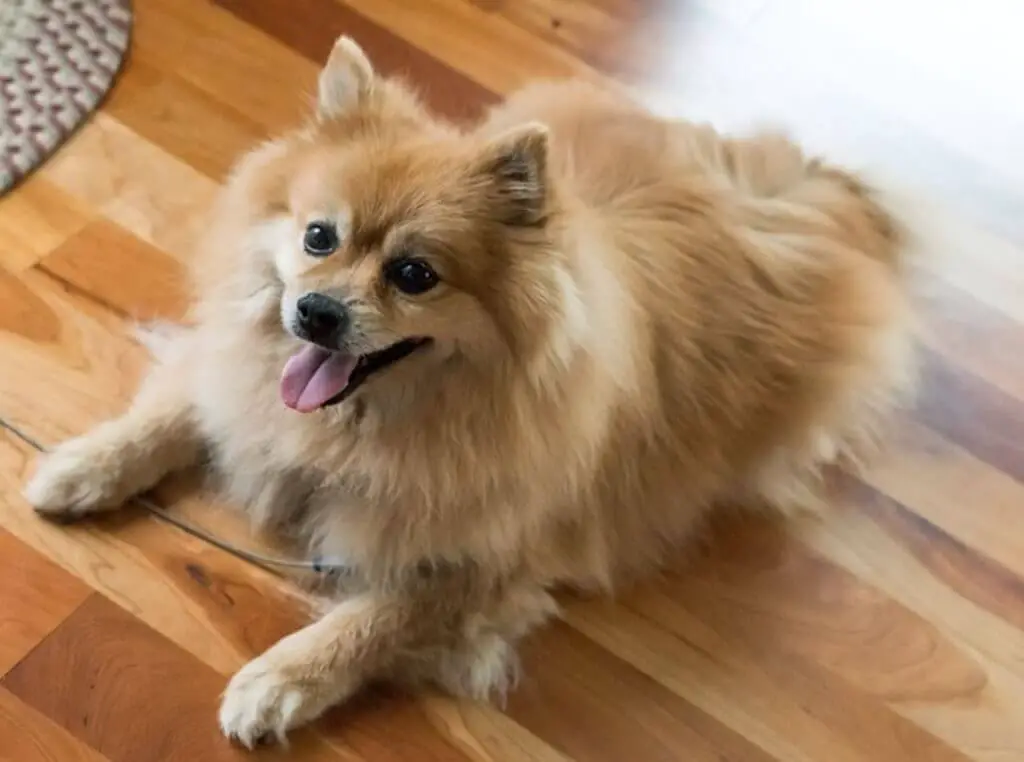Picture this: you’re scrolling through Instagram, and suddenly you see it, a tiny, fluffy Pomeranian that looks like a living teddy bear crossed with a cotton ball. Your heart melts instantly, but then your practical brain kicks in with that inevitable question: Do Pomeranians shed, and how much hair will I find tumbling around my house like miniature tumbleweeds?
Here’s the truth bomb: yes, Pomeranians shed. A lot. These tiny fluffballs pack an impressive amount of fur into their compact bodies, and they’re not shy about sharing it with your furniture, clothes, and basically every surface in your home. I’ve been living with my Pom, Duchess, for four years now, and I can tell you that the shedding situation is real, but it’s totally manageable once you know what you’re dealing with.
The Pomeranian Double Coat Reality
Understanding Their Luxurious Fur System
Pomeranians have what’s called a double coat, which sounds fancy until you realize it basically means twice the shedding potential. The outer coat consists of long, coarse guard hairs that give Poms their distinctive fluffy appearance. Underneath, they have a soft, dense undercoat that provides insulation and warmth.
This double coat system worked perfectly when these little guys were larger spitz-type dogs running around in cold climates. Now that they’ve been bred down to pocket size and spend their days lounging on heated floors, that double coat is mostly just a beautiful inconvenience for us humans.
The guard hairs are easier to spot and clean up, but that undercoat? It’s like dealing with microscopic fluff particles that somehow defy gravity and stick to everything. I swear I’ve found Duchess’s undercoat hairs sealed inside Tupperware containers.
How Much Shedding Are We Talking About?
Pomeranians are considered moderate to heavy shedders depending on the season and individual dog. During peak shedding periods, you’re looking at enough fur to stuff a small pillow. I’m only half-joking about that—I actually collected Duchess’s brushed fur for a week once, and the pile was impressively substantial for such a tiny dog.
Daily, you’ll find hair scattered around your home, but it’s manageable with regular grooming. The real shock comes during seasonal coat blowouts when your adorable little lion transforms into a fur-dispensing machine that seems physically impossible given their size.

Seasonal Shedding Cycles You Need to Know
Spring Shedding Season: The Great Fur Exodus
Spring hits, and suddenly your Pomeranian looks like they’re having an identity crisis. Spring shedding typically lasts 6-8 weeks as your Pom sheds their heavy winter undercoat to prepare for warmer weather.
During this time, I brush Duchess twice daily and still find enough fur around the house to knit a sweater for another small dog. The amount of undercoat that comes out during brushing sessions is honestly shocking. Sometimes I wonder if there’s actually a dog under all that fluff or just an elaborate fur-dispensing mechanism.
Fall Coat Changes: Preparing for Winter
Fall brings another major shedding period as Pomeranians shed their lighter summer coat and grow in their winter protection. This transition usually takes 4-6 weeks and involves both losing old hair and growing new, thicker undercoat.
The timing can vary based on your local climate and indoor heating, but most Poms start this process around September or October. You’ll notice the hair floating around your house has a different texture—it’s the coarser guard hairs making way for the new winter coat.
Year-Round Maintenance Shedding
Even outside peak seasons, Pomeranians shed consistently throughout the year. This baseline shedding is just their normal hair growth and replacement cycle. You’ll find a moderate amount of fur daily, which is completely normal for the breed.
What’s not normal is sudden, dramatic changes in shedding patterns. If your usually fluffy Pom starts shedding excessively outside of seasonal changes, or if you notice bald patches, that’s definitely worth a vet visit.
The Puppy Coat Transformation Drama
What Happens During the Puppy Coat Change
Here’s something that catches many new Pom parents off guard: the puppy coat change. Around 4-6 months old, Pomeranian puppies go through what I like to call “the ugly duckling phase” (though they’re never actually ugly, just temporarily less fluffy).
During this period, puppies shed their soft, fluffy puppy coat and start growing their adult double coat. The process can take several months, and your adorable fluffball might look a bit patchy or thin during the transition. Don’t panic—this is completely normal!
I remember frantically googling “is my Pomeranian going bald” when Duchess hit this phase. She looked like she’d been attacked by a very specific hair clipper that only targeted certain areas of her body. The vet assured me this was typical, and sure enough, she grew into a gorgeous adult coat.
Timeline and Expectations
The puppy coat change typically begins around 4-6 months and can continue until the dog is 12-18 months old. Some Poms go through this transition gradually, while others seem to shed their puppy coat all at once and leave you wondering where your fluffy baby went.
Adult coat texture is usually coarser and denser than puppy fur, which means it sheds differently too. Adult Pom hair tends to be more manageable during brushing sessions and doesn’t mat as easily as that super-soft puppy fluff.
Factors That Affect Pomeranian Shedding
Diet and Nutrition Impact
High-quality nutrition directly affects coat health and shedding patterns. Pomeranians eating cheap, filler-heavy foods often shed more because their skin and coat aren’t getting proper nutrients for healthy hair growth cycles.
I switched Duchess to a premium food with added omega-3 fatty acids about two years ago, and I noticed a definite improvement in her coat quality. Her fur became shinier, felt softer, and seemed to shed in more manageable amounts rather than the constant fur snow I was dealing with before.
Health Issues That Increase Shedding
Several health problems can cause excessive shedding in Pomeranians:
- Allergies: Both food and environmental allergies can cause increased shedding and skin irritation
- Thyroid problems: Hypothyroidism commonly affects Poms and can lead to coat changes and hair loss
- Stress: Major life changes, moving, or anxiety can trigger stress-related shedding
- Hormonal changes: Spaying/neutering, pregnancy, or heat cycles can temporarily affect shedding patterns
- Parasites: Fleas, mites, or other skin parasites can cause excessive scratching and hair loss
Environmental Factors
Indoor climate control plays a bigger role in shedding than many people realize. Pomeranians living in homes with consistent temperatures and humidity levels often have more predictable shedding patterns than dogs exposed to dramatic environmental changes.
Dry indoor air, especially during winter heating seasons, can increase shedding and cause skin irritation. I run a humidifier in my main living areas during winter, and it seems to help keep Duchess’s coat in better condition.

Grooming Strategies That Actually Work
Daily Brushing Techniques
Regular brushing is absolutely essential for managing Pomeranian shedding. I use a combination of tools depending on what Duchess’s coat needs that day:
- Pin brush: Perfect for daily maintenance and working through the outer coat
- Slicker brush: Great for catching loose undercoat during shedding seasons
- Undercoat rake: Essential during major shedding periods for pulling out that dense undercoat
- Metal comb: Helps check for mats and ensures you’ve brushed thoroughly
The key is developing a routine that works for both you and your Pom. I spend about 10 minutes each evening brushing Duchess while she relaxes on my lap. It’s become our bonding time, and it prevents the hair situation from getting out of control.
Bathing and Professional Grooming
Monthly baths help manage shedding by loosening dead hair and keeping the skin healthy. I use a gentle dog shampoo followed by a conditioning treatment designed for double coats. The conditioning step is crucial—it helps prevent mats and makes brushing easier.
Professional grooming every 6-8 weeks can be a game-changer for managing Pomeranian shedding. A good groomer will do a thorough deshedding treatment and can trim areas that tend to mat easily. Just make sure your groomer understands Pomeranian coats and won’t shave your fluffball down to nothing.
Tools That Make a Real Difference
Invest in quality grooming tools—they’re worth every penny when you’re dealing with a double-coated breed. Cheap brushes break easily and don’t effectively remove the undercoat that causes most shedding problems.
I swear by my undercoat rake for seasonal shedding periods. The first time I used one on Duchess during spring shedding, I couldn’t believe how much fur came out. It was like discovering a secret fur storage compartment I didn’t know existed.
Managing Pom Hair in Your Home
Strategic Vacuum Strategies
Let’s talk about vacuum cleaners because you’re going to become very familiar with yours. Pet-specific vacuums with strong suction and specialized brush rolls are essential for Pomeranian hair management.
I vacuum high-traffic areas daily and do a thorough whole-house vacuum twice a week. Robot vacuums can be helpful for daily maintenance, though they sometimes struggle with the longer guard hairs that get tangled around furniture legs.
Furniture and Fabric Choices
Leather furniture is your friend when you own a Pomeranian. Hair doesn’t embed in leather the way it does in fabric, making cleanup much easier. If you already have fabric furniture, washable covers are a must.
Avoid anything with deep pile or shag textures—Pomeranian hair will burrow into these fabrics and become nearly impossible to remove completely. I learned this lesson with a beautiful area rug that became a permanent hair collection device.
Air Filtration Systems
HEPA air purifiers can help manage airborne Pomeranian hair and dander. I run one in my main living area, and it definitely helps catch some of the floating fur particles that would otherwise settle on surfaces throughout the house.
Change your HVAC filters more frequently than usual—Pomeranian hair will clog them faster than you might expect. FYI, I go through filters about twice as fast as I did before getting Duchess.
Clothing and Personal Impact
Wardrobe Adjustments
You will make clothing choices based on Pomeranian hair visibility. Light-colored clothing shows dark Pom hair clearly, while dark clothing showcases those lighter undercoat hairs beautifully. Basically, you can’t win, so embrace the slightly furry look as part of Pom parenthood 🙂
I keep lint rollers everywhere—in my car, at my office, in every room of my house. They’re like tissues; you never realize how much you need them until you don’t have one handy.
Laundry Considerations
Dryer sheets become your best friend for reducing static that makes Pomeranian hair cling to everything. I add an extra dryer sheet when washing items that tend to collect dog hair, and it makes a noticeable difference in how much fur transfers to other clothes.
Washing pet bedding and your own clothes separately helps prevent hair transfer. Nobody wants to put on a “clean” shirt only to discover it’s been seasoned with a light coating of Pomeranian undercoat.
Special Considerations for Pomeranian Owners
Apartment Living Challenges
Small living spaces can make Pomeranian shedding feel more overwhelming because the hair has nowhere to disperse. Regular cleaning becomes even more important when you’re dealing with limited space.
I live in a one-bedroom apartment with Duchess, and I’ve learned that staying ahead of the hair situation is crucial. Daily brushing and frequent vacuuming prevent the fur from building up to overwhelming levels.
Multiple Pet Households
If you’re considering adding a Pomeranian to a multi-pet household, factor in the combined shedding situation. Different coat types shed differently, and you might find yourself dealing with a variety of hair textures and colors floating around your home.
Travel Preparations
Car travel with a Pomeranian requires some planning. Seat covers are non-negotiable unless you want your car interior permanently decorated with tiny dog hairs. I use waterproof covers that I can easily remove and wash after trips.
Hotel stays can be tricky because Pomeranian hair travels with you. I always pack a small handheld vacuum and extra lint rollers when we travel overnight.

Breed Comparisons and Expectations
How Poms Compare to Other Small Breeds
Compared to other toy breeds, Pomeranians are definitely on the heavier shedding end of the spectrum. Breeds like Yorkshire Terriers or Maltese shed much less due to their different coat types.
However, Poms shed less than double-coated medium or large breeds like Golden Retrievers or German Shepherds. It’s all relative—you’re dealing with a lot of hair from a very small dog, which can feel overwhelming but is actually manageable with proper grooming.
Realistic Timeline Expectations
The first year with a Pomeranian involves the steepest learning curve for hair management. You’ll figure out your dog’s individual shedding patterns, develop grooming routines, and adjust your home maintenance schedule.
After that first year, most Pom parents find a rhythm that works. The shedding doesn’t decrease, but your management systems become second nature, and you stop noticing it as much.
Long-Term Pomeranian Ownership Reality
What Changes Over Time
Senior Pomeranians often experience changes in their coat quality and shedding patterns. Some older dogs shed less as their hair growth slows, while others develop skin issues that can increase shedding.
Duchess is only four, so I haven’t experienced senior coat changes yet, but I’ve talked to other Pom owners who say the texture and shedding patterns can shift as dogs age. Regular vet checkups help monitor any significant changes.
Seasonal Routine Development
After several years with a Pomeranian, you’ll develop seasonal routines that help manage the major shedding periods. I know spring is coming not because of the weather, but because Duchess starts leaving little fur tumbleweeds in corners where they never appeared before.
Having systems in place makes those intense shedding seasons much more manageable. Extra brushing sessions, more frequent vacuuming, and strategic use of air purifiers become automatic responses to seasonal coat changes.
Making the Decision: Is Pom Shedding Worth It?
Honest Cost-Benefit Analysis
Yes, Pomeranians shed significantly, but they’re also incredibly rewarding companions. The daily hair management becomes routine, and most Pom parents agree that the joy these little personalities bring far outweighs the inconvenience of extra cleaning.
The shedding is predictable and manageable with proper care. It’s not like dealing with a behavioral issue that might never resolve—it’s just part of the Pomeranian package that you can successfully manage with the right approach.
Personal Reflection
IMO, the biggest adjustment isn’t the amount of shedding, but accepting that you’ll never have a completely hair-free home again. Once I stopped fighting that reality and just incorporated hair management into my regular routine, life with Duchess became much more enjoyable.
Watching her prance around like a tiny lion, full of attitude and affection, makes every lint roller purchase worth it. Plus, there’s something oddly satisfying about a good brushing session where you remove impressive amounts of undercoat—it’s like a weird accomplishment.
Final Thoughts
So, do Pomeranians shed? Absolutely, and quite impressively for their size. But here’s the thing—most Pom parents will tell you that once you fall in love with one of these fluffy little characters, the shedding becomes just another part of life, like doing dishes or checking the mail.
The key is going into Pomeranian ownership with realistic expectations and the right tools. Stock up on quality brushes, invest in a good vacuum, and prepare to make lint rollers a permanent part of your shopping list. Your reward will be a devoted, entertaining companion who thinks they’re much larger than they actually are and will fill your life with personality and yes, quite a bit of fur.
Duchess just walked by my desk, leaving a small trail of undercoat in her wake because apparently it’s time for her evening shed session. I’ll grab the lint roller in a minute, but right now I’m just enjoying watching my tiny diva survey her kingdom from the couch. That’s Pomeranian life—fluffy, fabulous, and absolutely worth every stray hair.


